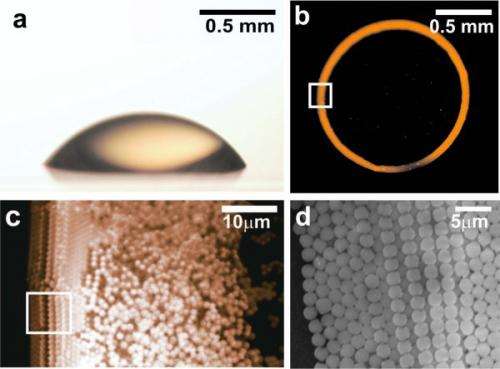Basic science in evaporating droplets

What happens if you slowly evaporate a droplet containing dissolved particles? The question sounds simple, but it involves a surprising amount of basic physics and mathematics. Hanneke Gelderblom of the University of Twente devoted a full four years of research to this problem, looking into a variety of aspects including the physics behind coffee stains. "I found this study to be particularly interesting because of the combination of theory and experimentation." Gelderblom will defend her doctoral dissertation on 19 April.
Coffee drinkers know the problem all too well: drops of spilled coffee leave a dark ring on the outside, while the inside of the stain dries up much lighter. PhD candidate Hanneke Gelderblom says that ever since a researcher at the University of Chicago published on the coffee stain problem in 1997, there has been mounting interest in this topic in academic circles. She explains the reason for this interest: "Many industrial applications can benefit from the coffee stain effect. In addition, there are many fields where these kinds of stains must be avoided, for example in printing or in the coatings industry. In both cases you need to know exactly how the stains are formed."
Simple
The system Gelderblom researched is in fact very simple: a drop of water containing micrometre particles (polystyrene beads) on a surface. Gelderblom looked at what happens when the droplet slowly evaporates.
"A simple basis like this is ideal for experimentation, because everything can be modelled reasonably well. There were many unknowns. Basic research is like a journey of understanding where you really get down to the fundamentals. I enjoy that, and theory and experimentation went hand in hand in this research."
Order
Gelderblom and her fellow researchers discovered quite a bit in the past few years. "For example, I was surprised to find that the rings that remain after evaporation feature neatly arranged particles around the edges, while there is significantly less order in the middle." Gelderblom found a conclusive explanation for this phenomenon in the interplay of three factors: droplet evaporation, fluid flow and particle transport.
In another experiment Gelderblom and her colleagues evaporated the particle-infused droplets on a super-hydrophobic surface (a material that is extremely water-repellent). After the droplets had evaporated, the particles were neatly arranged in a ball shape. "This arrangement of the particles approached that of a dense sphere, which is theoretically the most ideal arrangement for particulate matter."
Another breakthrough stemming from this research is the accurate mathematical model that Gelderblom was able to construct to express flow in the edge of the droplet. The model shows that flow is dependent on the angle of the droplet with the surface.
More information: Hanneke Gelderblom conducted her PhD research at the Department of Physics of Fluids. This research group is part of the University of Twente's MESA+ Institute for Nanotechnology. Gelderblom was supervised by Detlef Lohse and Jacco Snoeijer. She will defend her dissertation in the Waaier Building on the University of Twente campus on 19 April at 16:45.
Provided by University of Twente



















